- Characteristics
- Reviews
- Video
The recognizable design of the Volvo VNL 780: the wedge-shaped cab and headlights increase the aerodynamic characteristics of the car.
Among long-haul tractors, vehicles from the Volvo Trucks concern, which has the largest production facilities in the world, are widely known. The first generation of “Americans” - hooded truck tractors - came out with the VN marking. The tractors produced by the American branch of Volvo since the late nineties were initially available only to car owners in the United States and neighboring Canada. At the beginning of the 2000s, the concern produced the Volvo VNL 780 tractor - one of the last representatives of the first generation of the line of long-range vehicles. By that time, the habitat of the VN family had reached the European continent.
Specifications Volvo VNL 780
The development of a new long-range model, the Volvo VNL 780, was based on the already existing VNL 770 truck. The distinctive feature was not the improved technical parameters (which Volvo has always been excellent), but the attention to driver comfort. Banking on the love of American truckers for space inside the car, Volvo hit the bull's eye: the new VNL 780 became a revelation in the world of long-haul trucks. Huge, without exaggeration, the cabin received updated berths, now measuring no less than 2 meters in length and just over a meter in width. In addition, the lower seat can be transformed into a table with two seats (similar to the side seats in domestic second-class train carriages).
On five square meters, which is the area of the cabin, new additional drawers and cabinets have appeared. Lighting has been added: numerous light bulbs create a warm, cozy atmosphere, along with an audio system installed around the entire perimeter of the cabin. All this creates ideal conditions for long, tiring journeys and rest between transports. 2.5 meters of height allows you to walk in the cabin with your head held high. Amazingly, Volvo designers did not forget about the TV, microwave and mini-fridge. For a more tourist-like view, side mirrors were installed in the rear of the cabin. Not a car, but real travel apartments.

Volvo VNL 780 berths provide quality rest and the opportunity to dine in a cozy atmosphere.
Technical side
In addition to its recognizable appearance - which is just the elegant, curly headlights and neat radiator grille - the Volvo 780 tractor received good technical equipment. The engine brand remained unchanged: the same, time-tested and kilometers-tested, powerful (up to 500 hp) 12-liter Cummins ISX. The fuel consumption of this unit ranges from 36 to 42 liters - this is affected by the vehicle load and the selected travel mode. The presence of cruise control helps optimize fuel consumption. Savings of up to 3% (Volvo Trucks claim) are possible by maintaining a consistent speed on flat roads and downhill grades.
More on the topic: Cascadia ˗ Freightliner's flagship model
The maximum developed speed is 100 km, which is quite typical for the Volvo VNL 780 (the technical characteristics of which are designed primarily for towing about 60 tons) and similar equipment. The fact that Volvo is an avid road worker is also evidenced by the huge six-hundred-liter fuel tanks. As for the issue of environmental safety, the manufacturer approaches the matter very responsibly: the engine complies with the Euro-4 standard. It should be noted that the topic of ecology has always been a favorite topic for Volvo Trucks: the company has been developing alternative fuels for several years (currently dimethyl ether is used in some models), actively using modern filtration systems and high-pressure fuel injection, which significantly reduces the harmful effects on environment.

The Volvo VNL 780 is capable of towing about 60 tons; this power is provided by a 500 hp power unit. and frame characteristics.
A typical American tractor is a kind of construction kit. The vehicle is equipped by specialized companies that produce components; only the frame structure, body, and installed electrical equipment remain original. Thus, gearboxes are supplied by Meritor and Eaton-Fuller, and engines for long-distance vehicles are produced by three giants: Cummins, Caterpillar and Detroit Diesel. True, Volvo Trucks also has “native” engines, but apparently does not use them so often in its long-haul variants. This approach to vehicle configuration is associated with the specific American market: truck tractors, as a rule, are made to order.
Transmission and design features
Driving without problems and difficulties begins with the technology inside the cabin. The non-standard design of the handbrake is striking - a large yellow button. It has two functions: the parking brake itself and releasing the wheel locks. The car has an on-board computer and a system diagnostic display: all devices are in full view of the driver. The already mentioned cruise control is supplemented by an important differential locking system between the axles (relevant in winter, and therefore in Russia).
Gearboxes are traditionally taken from ZF-Meritor and Eaton-Fuller: non-synchronized gearboxes or robotic versions based on them. By the way, Volvo trucks now receive an intelligent I-Shift transmission, a feature of which is an electronic control unit that allows the vehicle to select the optimal solution. This attention to control underlines the high class of Volvo Trucks. Power steering relieves the driver of additional physical effort: for a truck driver, driving should be as comfortable as for a passenger vehicle driver. The car's suspension is pneumatic, the front axle was developed by the Rockwell brand, and the rear axles were developed by Meritor. Despite such diversity of manufacturers, the air springs on the rear axle are original, Swedish.

The Volvo VNL 780 interior is spacious for both driver and passenger. The decision to replace the standard “handbrake” with a convenient and bright button was very opportune.
The Volvo VNL 780 is very popular among domestic truckers, reviews of which are presented in large numbers on Internet resources, and trucks of different model series are often found on the road. The reason for this is Volvo’s approach to the manufacture of specific vehicles, care for the driver, and the use of modern innovative systems in its cars. Domestic drivers love hooded tractors not only for their impressive interior, but also for the so-called “life meter” - a forward hood, which significantly increases driver safety in an emergency. We have to admit that this remains relevant on Russian highways due to the high number of accidents and the unsatisfactory condition of many highways. Not so long ago, production of Volvo trucks began to open in Russia, which affected the increase in the popularity of the brand.
More on the topic: Peterbilt 359: a legend from America
VT880
Pride and polish, “pride and polish” - this is the name of the beauty contests of long-haul tractors, which are held annually in the USA. At these competitions, sparkling with chrome and stainless steel, there are tractors in the “cowboy style”: Peterbilt, Kenwort, Western Star... But the Volvo brand is rare. And all because the American branch of this concern has not yet produced “cowboy” cars. Now such a model has emerged. Its index is VT880, and this is the most powerful main Volvo!
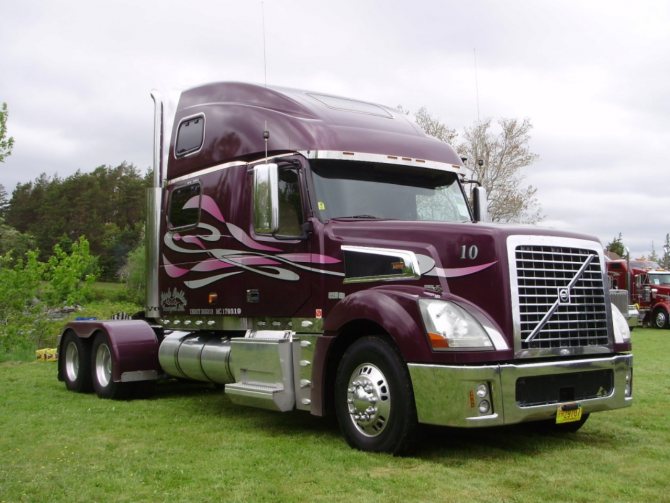
When it comes to American Volvos, I remember a long-ago conversation with the owner of such a “nosed” tractor (this was, of course, in the States). Then the American was sincerely surprised: “What, are there trucks of this brand in Europe too?” Either stand or fall... However, many Europeans do not suspect that overseas, in the USA, trucks with the familiar slash on the front end are also produced.
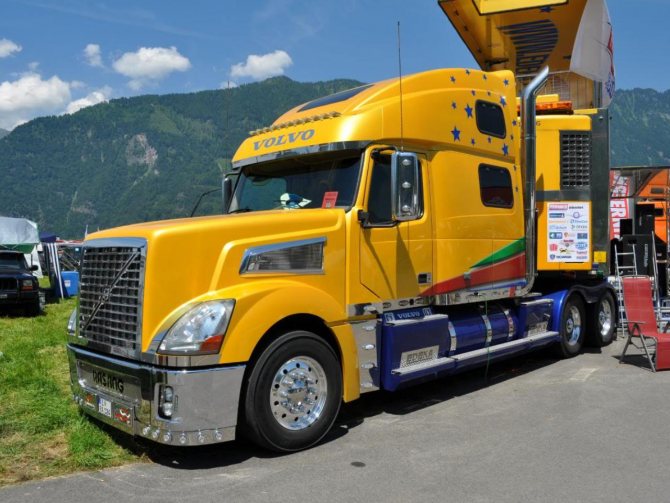
They were born back in the early eighties, when the Swedes gained control of the local “truck” company White. At first, the cars bore a double name, Volvo White, but then the Swedes abandoned the White prefix, and the company became simply one of the divisions of the Volvo concern.
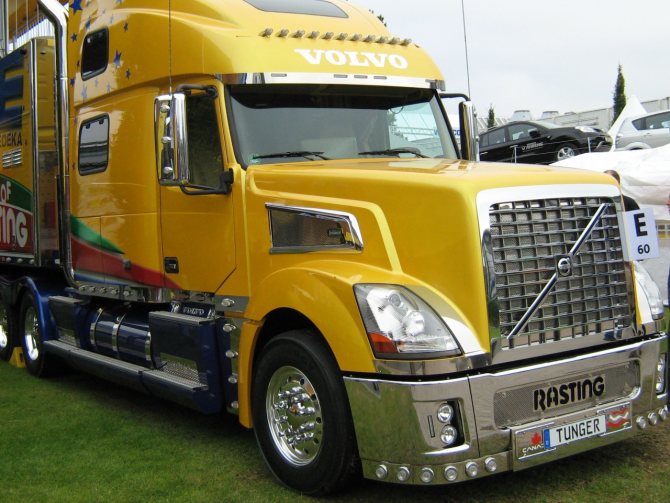
It is not surprising that the current American tractors of this brand are unified with their European counterparts. Even the front panel in the cockpit is almost the same. But at the same time, overseas Volvo tractors are purebred “Americans” with a long nose and a hefty sleeping compartment. True, there is one “but”: until now, these machines have been aimed exclusively at large transport companies.
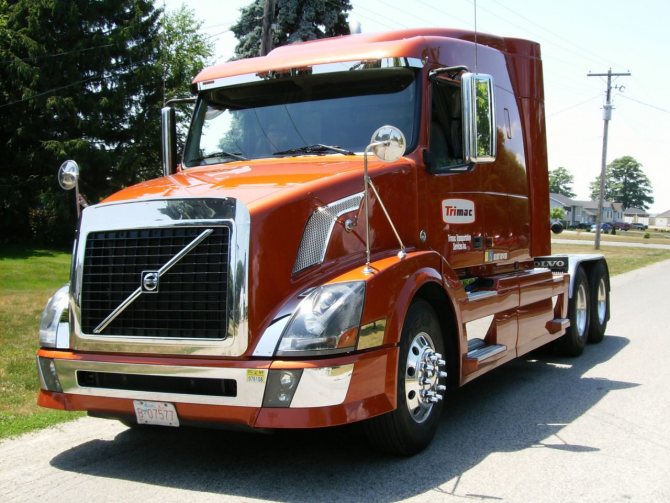
It should be noted that in the States there is a clear division of tractors - for large fleets (fleet trucks) and for “private owners” (owner-operator trucks). Fleet trucks have streamlined, “sleek” shapes, an interior without any frills, and, of course, no “chrome or polishing.” In fact: why do they need a boss who owns hundreds of tractors? The main thing there is savings.
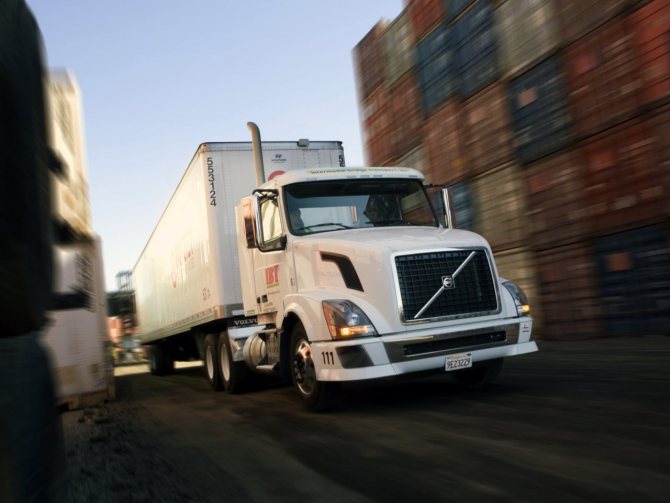
Another thing is American private truck drivers who own one, or at most several, cars. They will never give up their favorite “cowboy style”! “Cowboy” tractors are very easy to distinguish: they have a wide polished bumper, “steamboat pipes, fashionable at any time of the year,” air filters sticking out on both sides of the hood. Plus – a hefty “sleeper” and a very powerful engine (which, by and large, is not needed on highways that are as smooth as a runway). And - dozens of orange lights around the perimeter.
In general, not a tractor, but a favorite toy and a motor home at the same time! Of course, the aerodynamics and fuel consumption of these cars are far from ideal, but these are the laws of the genre. But the new Volvo VT880 is no longer just a “cowboy”, but a “cowboy of the 21st century”, adjusted for modern technologies. Even the orange lights here are not simple, but LED. The bumper, for example, is not made in the form of a flat “shovel”, but is neatly curved at the edges and consists of three parts - to make it easier to repair in the event of an accident.
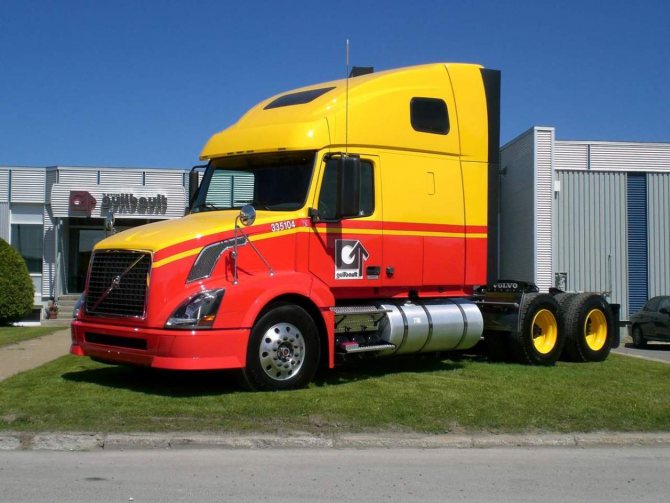
And the aerodynamics are all right: one roof acts as a giant spoiler, which is worth it! The exhaust pipes were removed behind the cabin, and the designers completely abandoned the “barrel” air filters placed outside: instead of them, stylish air intakes appeared, edged with “stainless steel”. By the way, the new engine needs a lot of air: under the hood there is a 16-liter Volvo D16 (almost the same as the European FH16 tractors, but locally assembled and with slightly different parameters). And if the “European” version develops a maximum of 610 hp, then here the power has been increased to 625 horsepower. Surely such a tractor, and with a full load, jokingly bypasses cars on the highway (after all, the “Americans” have no speed limiters)!
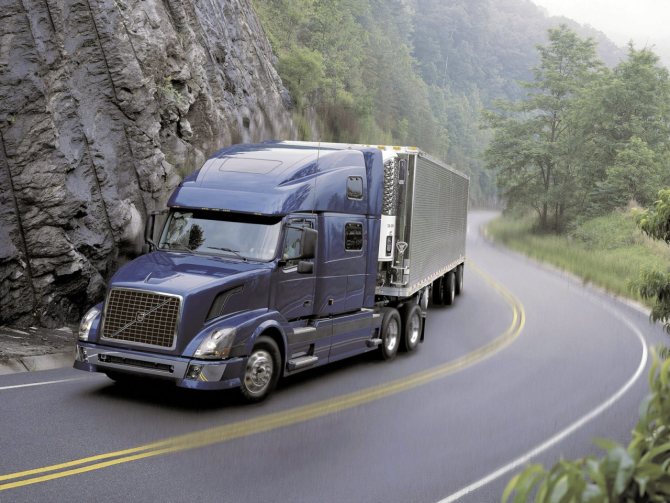
However, more modest options are also offered: 500 and 550 horsepower, and on request - a Cummins ISX engine with power from 475 to 565 horsepower. By the way, the transmission of the new car is not Volvo. Apparently, this is connected precisely with speed parameters: in Europe, tractors reach a maximum of 90 km/h (unless, of course, you “break” the limiter), in the USA - 120 km/h, or even more. The gearbox is Eaton (there are options with a regular lever and with an AutoShift “joystick”), axles are Dana Spicer or Meritor.
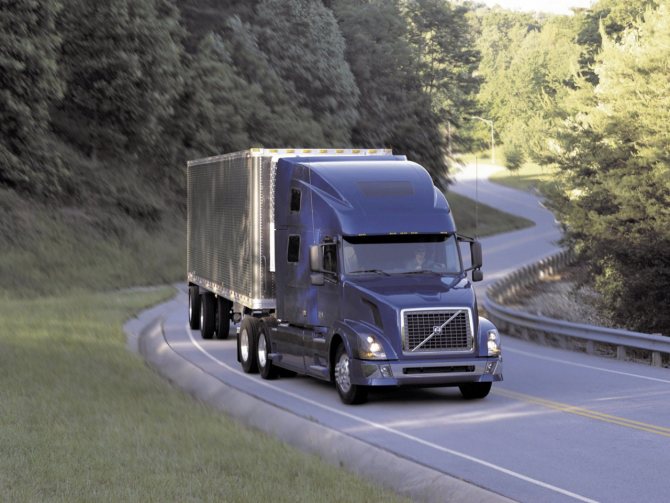
But that's not all. In addition to the “super engine”, a “super sleeper” is offered. Take a look at the photo: the lower bed turns into two sofas with a table, on the sides there are cabinets up to the ceiling, which house a refrigerator, a microwave, and even a pull-out washbasin (American tractors have never had this before!). Another unusual detail is the windows on both “tiers” of the sleeping compartment. “Cities, gardens, villages: you lie on the top shelf and look, look out the window, as the canvas flashes by. Eh, it’s good on the railway...” Yes, any passenger would envy such a compartment!
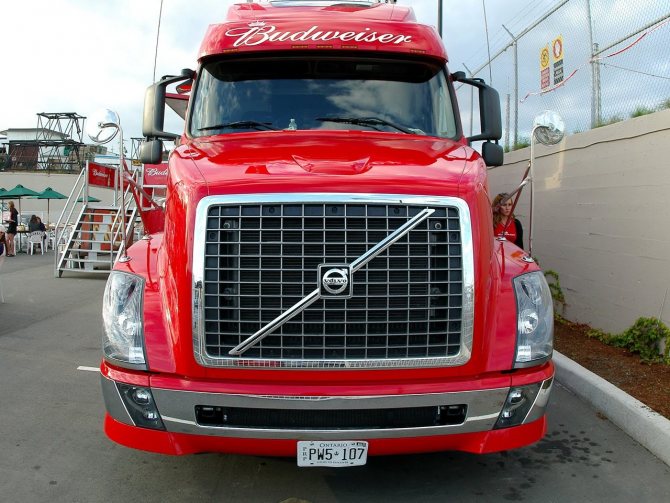
Especially considering that there are three finishes to choose from: Premiere (with a saddle shade), Elite Aurora and Elite Prism (with a brick shade). Moreover, if you believe the company’s statement, the quality of this finishing is at the level of high-class passenger cars. According to P. Carlsten, President of Volvo Truck Americas, “the new machine is very impressive, and its D16 engine is the most powerful in North America.” What's true is true. But the price of all this will probably be no less “impressive”...
©. Photos taken from publicly available sources.
- Author: Evgeny Smolnikov
Rate this article:
- 5
- 4
- 3
- 2
- 1
(5 votes, average: 5 out of 5)
Share with your friends!
9700
FMX
Volvo 780 Reviews
Andrey, Chelyabinsk. The car is produced in 2003.
The choice for work was between Fred (Freightliner), who already had driving experience, and Volvo. Naturally, we considered used options, since the price of a new one is by no means small - about 3.5 million rubles. In favor of Volvak, of course, is the presence of a “native” service in Chelyabinsk, and throughout Russia. Anything can happen on the road and the presence of stations is only a plus for the car. Spare parts are expensive, but there are far fewer problems with them, although it all depends on the model, of course. We took a Volvo VNL 780 hood with a mileage of 610,000 km. As for repairs, we naturally changed all the tires, since there was a fair amount of wear, springs, batteries and some small things. First of all, I am amazed by the cabin - I have never worked with such comfort. It’s not for nothing that in America drivers call this model “auto-home”. And the gearbox is very powerful, shifting is fast and precise.
The car holds up well on dirt roads and uphill slopes, but when heavily loaded with up to 40 tons, it tilts to one side, so you have to be careful, knowing our roads. There is also some heeling on a winding road. Experienced truck drivers just need to get used to such things. The presence of two stoves (Webasto) cannot but please us - you have to stand for a long time on the highway in winter for various reasons, and decent heating has helped out more than once. I drove different cars, including KAMAZ trucks - I can’t say anything bad about Volvo. I'm glad I had the opportunity to try this model.